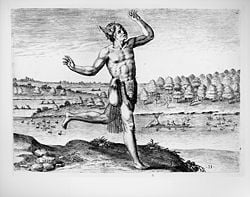Conjuration

The verb conjure is used to refer to the use of magic or spells to affect or bring something into being. As a noun, "conjure," is commonly used in the southern United States to refer to an act of folk magic performed by practitioners of hoodoo. Conjuring can also refer to the invocation of a spirit or devil, a practice that is widespread worldwide.
The distinction between those who claim to use true magic, known as magicians, and entertainers who practice the art of illusion is significant. Entertainment serves a valuable function for humankind in making us feel happy. Magicians, and other practitioners of magic, have a different purpose, sometimes for good and sometimes not. The professional conjuror can be relied upon to entertain and bring joy to his audience.
Conjuring as Ritual
Conjuring spirits has been part of the spiritual side of many cultures throughout history, including Native American cultures like the Cherokee, as well as cultures in medieval Europe, shamanism in Asia, and West African influenced hoodoo (Hudu). The conjuring of spirits has also been a part of many Wiccan practices and rituals.
Methods of Conjuring
Spirits can be conjured to aid and benefit, as or the destruction of an enemy. The conjuring of spirits is often associated with a certain amount of ritual, no matter what the culture. Charms have often been used to summon spirits, as well as magic or sacred symbols marked on the floor/ground, an altar, or embroidered on the clothing of the conjurer. Amulets and protective purification rituals to cleanse the body, mind, and soul are often used to ward off any potential harm that could befall the conjurer. Some rituals consider the hour of the day or night and the astrological configuration of the zodiac important to the success of a ritual. Incense and specific herbs may be used, often used in conjunction with candlelight to create a certain atmosphere.
In addition to the conjuring of spirits, the conjuring of the dead has also been practiced. Necromancy, or the act of conjuring the dead for divination, dates back to ancient times. In the Middle Ages, necromancy was widely practiced by magicians, sorcerers, and witches, until it was condemned by the Catholic Church. Necromancy is not currently practiced in Neo-pagan Witchcraft, but is still a part of Voodoo. Many consider necromancy to be a dark and repugnant practice.[1]
Good and Evil
Many Christian religions view conjuration, as well as other forms of magic, as an inherently evil practice, explicitly forbidden in the Old Testament. In societies that do not view magic as inherently evil, there exist those who use conjuring and other forms of magic for selfish and evil purposes. Known as black magicians, such individuals are not generally the rule, and have opposition amongst more traditional magicians.
Hoodoo
Not to be confused with the Voodoo religion, hoodoo is the practice of folk magic, primarily by African-Americans in the southern states. Originating in the nineteenth century or before, hoodoo incorporates African folkloric practices/beliefs with Native American botanical knowledge and European folklore. Hoodoo is also known as "conjuration," "conjure," "witchcraft," "rootwork," and "tricking." Practitioners of hoodoo may be known as "conjure men/women." Contrary to what such a term implies, hoodoo practitioners use neither invocatory magic or sleight of hand illusions; the only connection of hoodoo to conjuring is the use of the word.[2]
Notes
- ↑ "Necromancy" The Mystica. Retrieved May 15, 2007.
- ↑ Catherine Yronwode, "Hoodoo: African American Magic" Lucky Mojo. Retrieved May 15, 2007.
ReferencesISBN links support NWE through referral fees
- Mangan, Michael. 2007. Performing Dark Arts: A Cultural History of Conjuring Intellect Ltd. ISBN 1841501492
- Randi, James. 1992. Conjuring: A Definitive History. St Martins Press. ISBN 0312086342
Credits
New World Encyclopedia writers and editors rewrote and completed the Wikipedia article in accordance with New World Encyclopedia standards. This article abides by terms of the Creative Commons CC-by-sa 3.0 License (CC-by-sa), which may be used and disseminated with proper attribution. Credit is due under the terms of this license that can reference both the New World Encyclopedia contributors and the selfless volunteer contributors of the Wikimedia Foundation. To cite this article click here for a list of acceptable citing formats.The history of earlier contributions by wikipedians is accessible to researchers here:
The history of this article since it was imported to New World Encyclopedia:
Note: Some restrictions may apply to use of individual images which are separately licensed.